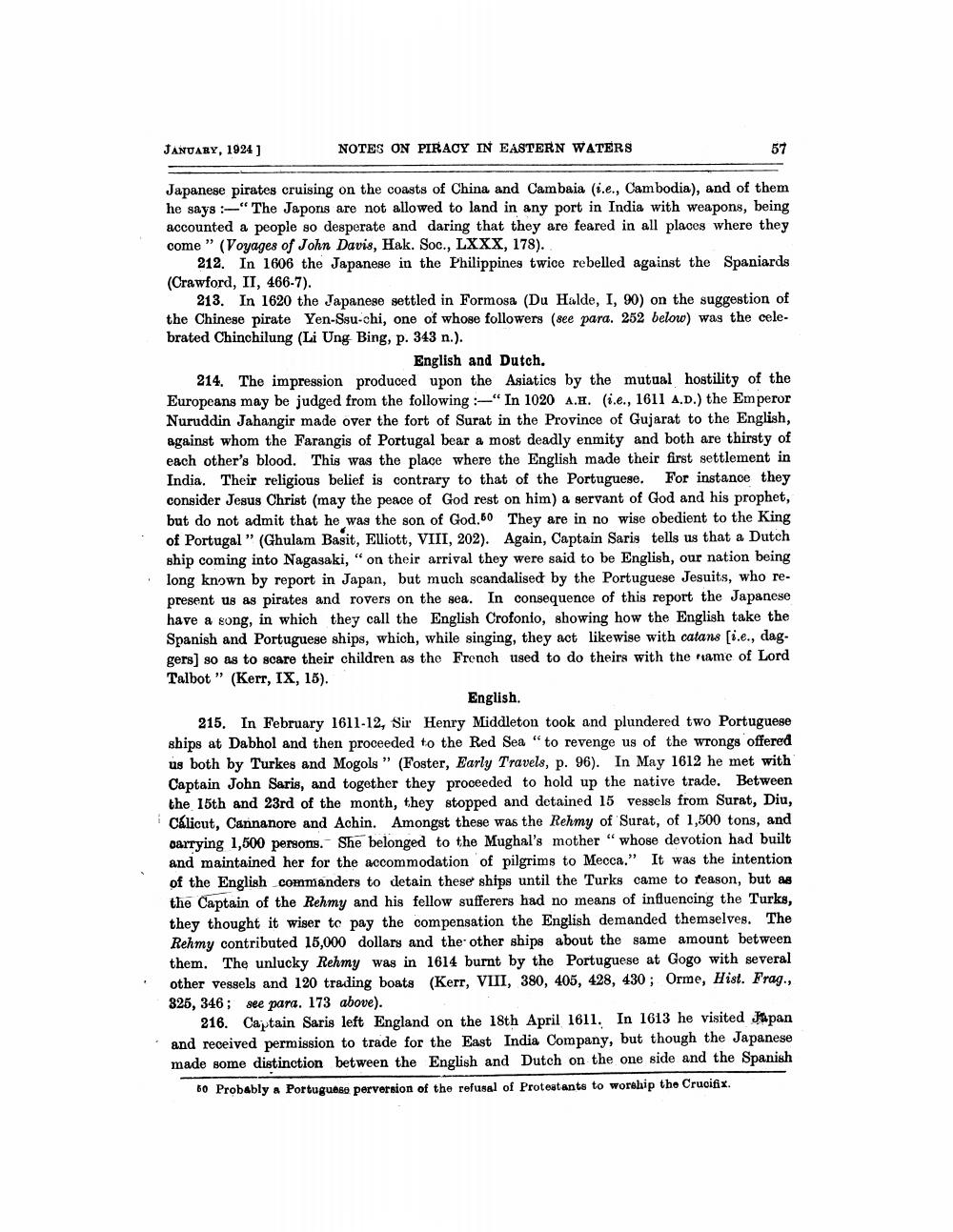________________
JANUARY, 1924]
NOTES ON PIRACY IN EASTERN WATERS
57
Japanese pirates cruising on the coasts of China and Cambaia (i.e., Cambodia), and of them he says "The Japons are not allowed to land in any port in India with weapons, being accounted a people so desperate and daring that they are feared in all places where they come" (Voyages of John Davis, Hak. Soc., LXXX, 178).
212. In 1606 the Japanese in the Philippines twice rebelled against the Spaniards (Crawford, II, 466-7).
213. In 1620 the Japanese settled in Formosa (Du Halde, I, 90) on the suggestion of the Chinese pirate Yen-Ssu-chi, one of whose followers (see para. 252 below) was the celebrated Chinchilung (Li Ung Bing, p. 343 n.).
English and Dutch.
214. The impression produced upon the Asiatics by the mutual hostility of the Europeans may be judged from the following:-" In 1020 A.H. (i.e., 1611 A.D.) the Emperor Nuruddin Jahangir made over the fort of Surat in the Province of Gujarat to the English, against whom the Farangis of Portugal bear a most deadly enmity and both are thirsty of each other's blood. This was the place where the English made their first settlement in India. Their religious belief is contrary to that of the Portuguese. For instance they consider Jesus Christ (may the peace of God rest on him) a servant of God and his prophet, but do not admit that he was the son of God.50 They are in no wise obedient to the King of Portugal" (Ghulam Basit, Elliott, VIII, 202). Again, Captain Saris tells us that a Dutch ship coming into Nagasaki, "on their arrival they were said to be English, our nation being long known by report in Japan, but much scandalised by the Portuguese Jesuits, who represent us as pirates and rovers on the sea. In consequence of this report the Japanese have a song, in which they call the English Crofonio, showing how the English take the Spanish and Portuguese ships, which, while singing, they act likewise with catans [i.e., dag. gers] so as to scare their children as the French used to do theirs with the name of Lord Talbot" (Kerr, IX, 15).
English.
215. In February 1611-12, Sir Henry Middleton took and plundered two Portuguese ships at Dabhol and then proceeded to the Red Sea "to revenge us of the wrongs offered us both by Turkes and Mogols" (Foster, Early Travels, p. 96). In May 1612 he met with Captain John Saris, and together they proceeded to hold up the native trade. Between the 15th and 23rd of the month, they stopped and detained 15 vessels from Surat, Diu, Calicut, Cannanore and Achin. Amongst these was the Rehmy of Surat, of 1,500 tons, and carrying 1,500 persons. She belonged to the Mughal's mother "whose devotion had built and maintained her for the accommodation of pilgrims to Mecca." It was the intention of the English commanders to detain these ships until the Turks came to reason, but as the Captain of the Rehmy and his fellow sufferers had no means of influencing the Turks, they thought it wiser to pay the compensation the English demanded themselves. The Rehmy contributed 15,000 dollars and the other ships about the same amount between them. The unlucky Rehmy was in 1614 burnt by the Portuguese at Gogo with several other vessels and 120 trading boats (Kerr, VIII, 380, 405, 428, 430; Orme, Hist. Frag., 325, 346; see para. 173 above).
216. Captain Saris left England on the 18th April 1611. In 1613 he visited Japan and received permission to trade for the East India Company, but though the Japanese made some distinction between the English and Dutch on the one side and the Spanish
50 Probably a Portuguese perversion of the refusal of Protestants to worship the Crucifix.




